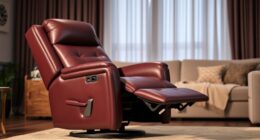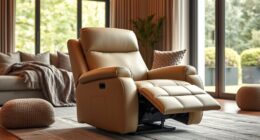To create chic furniture layouts that simplify aging in place, focus on open spaces that enhance mobility and safety. Choose comfortable, accessible furniture with stable designs and rounded edges. Keep pathways clear and remove clutter to reduce fall risks. Utilize multi-functional pieces to maximize space and incorporate smart technology for added convenience. Comfortable seating is essential, with heights that aid in standing and sitting. Discover more ideas that can transform your home into a stylish and safe haven!
Key Takeaways
- Choose an open floor plan to ensure clear pathways of at least 5 feet by 5 feet for safe navigation with mobility aids.
- Incorporate multi-functional furniture that maximizes space while providing built-in storage to reduce clutter and enhance accessibility.
- Select seating with heights between 17-19 inches to facilitate easy transitions between sitting and standing, promoting independence.
- Arrange furniture away from doorways to maintain smooth movement and eliminate trip hazards like clutter and electrical cords.
- Utilize smart technology, such as motion sensor lights, to enhance safety and convenience during nighttime navigation.
Importance of Open Spaces for Senior Safety
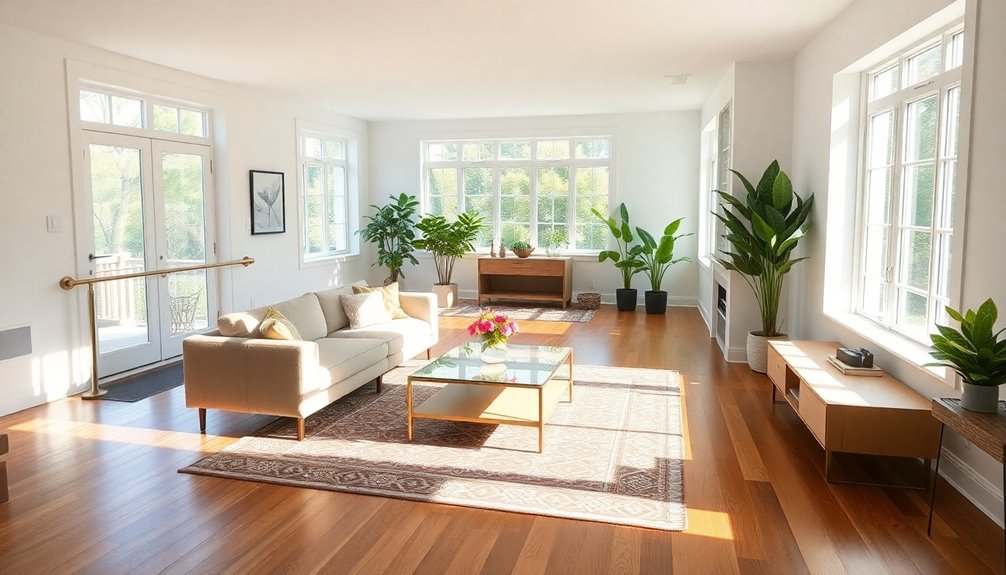
When it comes to creating a safe home for seniors, open spaces play an important role in enhancing mobility and reducing fall risks. By maintaining a minimum clearance of 5 feet by 5 feet, you guarantee that seniors using mobility aids like walkers or wheelchairs can navigate without obstruction.
Eliminating clutter and keeping paths clear greatly lowers the chances of falls, a major concern for senior safety. An open layout not only facilitates easy access to essential areas like the kitchen and bathroom but also promotes independence.
Wider doorways of at least 36 inches enhance wheelchair accessibility, allowing free movement between rooms. Additionally, open spaces encourage social interaction, which is critical for mental health and ultimately boosts their quality of life.
Choosing the Right Furniture for Accessibility

When choosing furniture for accessibility, prioritize comfort and support to help seniors sit and stand with ease.
Opt for stable pieces that maximize space for mobility, ensuring pathways remain clear for walkers or wheelchairs.
Your selections can make daily activities safer and more enjoyable for those aging in place.
Prioritize Comfort and Support
Comfort and support are essential in creating a living space that caters to seniors' needs. Opt for furniture with seat heights between 17-19 inches, making it easier for them to sit and stand. Lift chairs are a fantastic option, providing vital support for those with mobility limitations. Additionally, dementia medications can also play a role in ensuring that seniors are comfortable and can engage with their surroundings effectively. Incorporating smart home devices can further enhance their living experience by allowing for easier control of appliances and lighting.
Choose tables that are easily reachable from seating areas to prevent straining during meals or activities, enhancing overall comfort and usability. Additionally, incorporating rounded edges on furniture helps reduce injury risks, promoting safety in the home.
Finally, guarantee that all furniture is stable and equipped with non-slip feet to prevent sliding, allowing for safe navigation throughout the space. Establishing consistent routines will also greatly improve daily living for seniors. Prioritizing these aspects will greatly improve daily living for seniors.
Optimize Space for Mobility
To guarantee seniors can navigate their homes with ease, optimizing space for mobility is essential. Choose furniture that meets specific space requirements, like a seat height of 17-19 inches for easy shifts. Lift chairs offer additional support, enhancing independence. Additionally, federal funding can help support modifications for seniors aging in place. Ascertain you have at least 5 feet by 5 feet of clear space around furniture to accommodate bulky mobility aids like walkers or wheelchairs. This mental clarity allows seniors to focus on their daily activities without the added stress of navigating cluttered spaces. Additionally, selecting furniture that complements the home's overall design can create a more inviting and functional environment for seniors to thrive in aging in place.
Here's a quick overview to help you choose the right furniture:
| Furniture Type | Benefits |
|---|---|
| Lift Chairs | Supports easy standing and sitting |
| Adjustable Height Tables | Comfortably used over laps |
| Rounded Furniture | Reduces injury risk from sharp corners |
Enhancing Navigation With Thoughtful Layouts
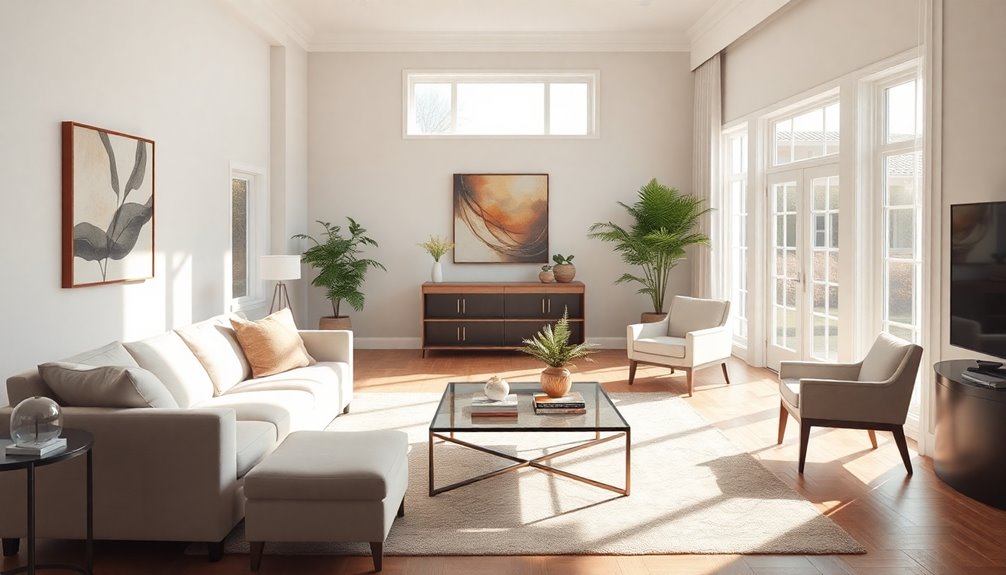
To enhance navigation in your living space, keep pathways clear and spacious, ensuring there's at least a 5 x 5 area for easy maneuvering.
An open floor plan can make your home more accessible, allowing for flexible furniture arrangements that adapt to your needs. Additionally, incorporating family-friendly environments can create a welcoming atmosphere for all ages. Consider the use of zoning regulations to ensure that your tiny house layout complies with local laws and maximizes usability. Understanding astrological compatibility may also help in creating harmonious spaces that reflect the personalities of all residents.
Clear Pathways for Safety
Creating a safe and accessible living space is essential, especially for those using mobility aids. Start by maintaining clear pathways of at least 5 feet by 5 feet, which allow easy navigation and considerably reduce the risk of falls. Effective co-parenting plans can help ensure that children's needs are prioritized during the transition to a new living environment.
Remove trip hazards like clutter, sharp edges, and electrical cords to enhance safety and accessibility. An open floor plan is ideal, as it offers flexible furniture arrangements and can adapt to changing mobility needs over time. Additionally, consider integrating air purifiers to improve indoor air quality, which can contribute to overall health and well-being.
Ascertain furniture is positioned away from doorways and maintain a minimum of 3 feet wide thresholds for smoother movement. Regularly assess your layout to identify potential hazards and keep pathways unobstructed, promoting independence and safety for aging individuals. Additionally, consider integrating home security systems to further enhance the safety of the living environment.
Accessible Furniture Arrangements
Ensuring clear pathways sets the stage for accessible furniture arrangements that enhance navigation throughout your living space.
By thoughtfully arranging your furniture, you can considerably reduce potential tripping hazards and create a safer environment for aging in place. A well-designed layout can significantly improve the quality of life for seniors, making everyday activities easier and more enjoyable. Additionally, incorporating water efficiency features in bathrooms can contribute to a more sustainable living space, benefiting everyone.
- Maintain a cleared 5 x 5 space for easy movement with mobility aids.
- Position seating within easy reach of tables to support safer changes.
- Choose furniture with rounded edges to minimize injury risks.
- Incorporate adjustable pieces, like lift chairs, for versatile comfort.
These strategies make it easier to maneuver while providing ample space around furniture. Regular home cleaning can further enhance this environment by preventing buildup of dirt and grime, ensuring a fresh living space.
A well-planned layout promotes independence, allowing you or your loved ones to move freely and safely within the home.
Utilizing Multi-Functional Furniture
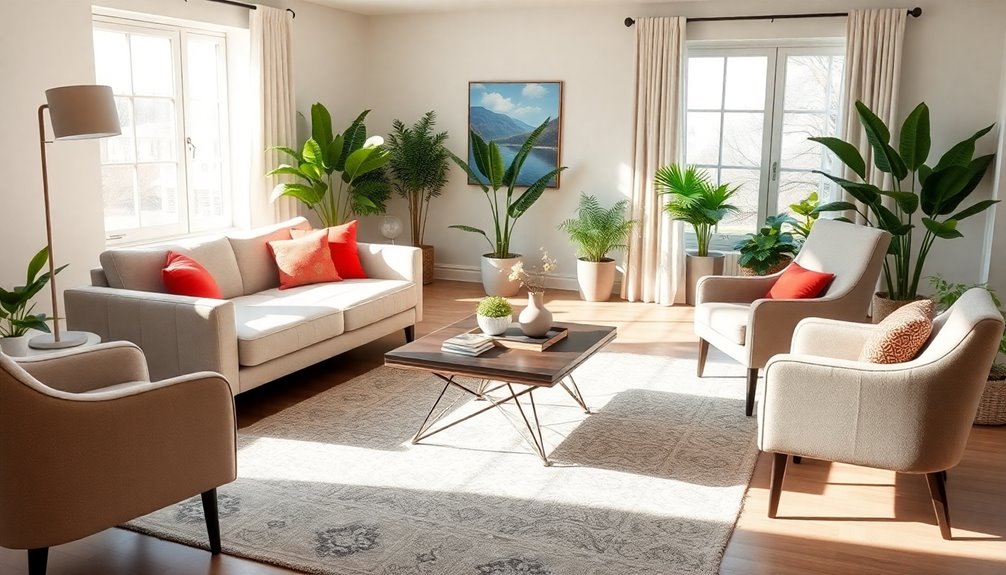
When you embrace multi-functional furniture, you're not just maximizing space; you're also enhancing comfort and accessibility in your home.
Items like lift chairs and adjustable-height tables support both sitting and standing, catering to various activities while promoting senior health.
Opt for furniture with built-in storage, such as ottomans or coffee tables with compartments, to keep your space clutter-free, reducing tripping hazards and simplifying movement for those using mobility aids.
Sofa beds and daybeds offer flexible seating and sleeping arrangements, perfect for accommodating guests.
Additionally, nesting tables and lightweight furniture with wheels allow easy maneuverability, adapting to changing needs over time.
This thoughtful approach creates a harmonious environment that promotes independence and well-being.
Incorporating Smart Technology in Living Rooms
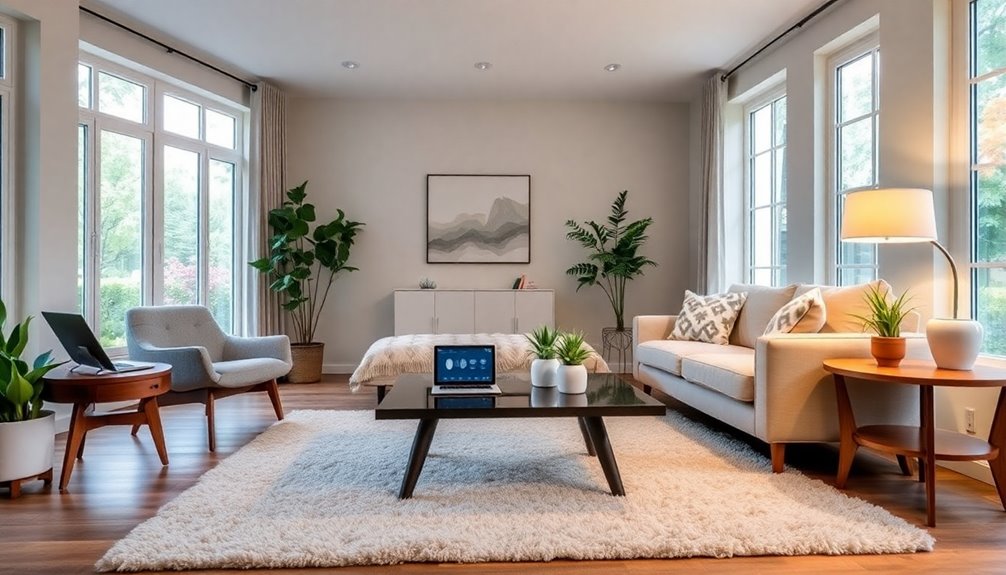
As you explore ways to enhance your living space with multi-functional furniture, consider how incorporating smart technology can further support comfort and independence.
This technology not only makes daily tasks easier but also enhances safety, especially for those aging in place.
- Remote control of lights and door locks reduces fall risks.
- Virtual home assistants allow easy task management via voice commands.
- Smart lighting solutions, like motion sensors, improve visibility without getting up.
- Medical alert systems offer quick access to help in emergencies.
Additionally, integrating smart home utilities can lead to improved energy efficiency and comfort, making the living environment more pleasant.
Optimizing Lighting for Improved Visibility

Optimizing lighting in your home can greatly enhance visibility, especially for seniors whose eyesight may be affected by age.
To guarantee adequate lighting, incorporate multiple sources like floor and table lamps for even illumination. LED lighting is a fantastic choice due to its energy efficiency and ability to minimize headaches and mood disorders.
Installing motion sensor lights in hallways and entryways enhances safety, allowing seniors to navigate without fumbling for switches in the dark.
Additionally, consider task lighting, such as adjustable desk lamps or under-cabinet lights, to improve visibility for specific activities.
Finally, utilizing light dimmers allows you to customize brightness levels, promoting comfort and ease of movement throughout your living space.
Creating Comfortable Seating Arrangements
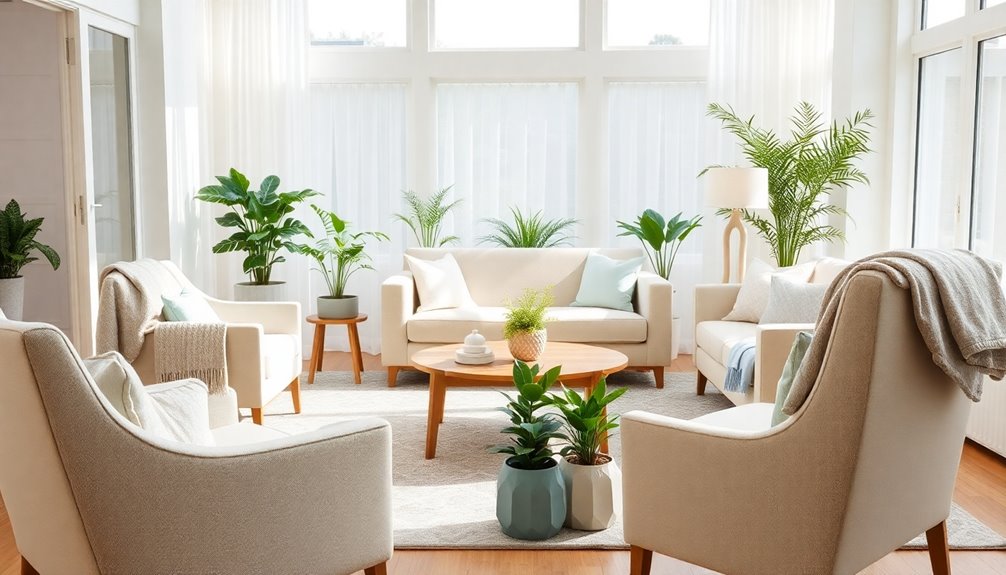
When you're creating comfortable seating arrangements, prioritize accessibility and space to make movement easier for seniors.
Incorporating supportive furniture, like lift chairs, can enhance safety and comfort while ensuring there's enough room to navigate.
Don't forget to enhance the ambiance with lighting that complements your layout, making the space inviting and functional.
Prioritize Accessibility and Space
Creating comfortable seating arrangements is essential for seniors who want to age in place with ease.
Prioritizing accessibility and space guarantees that you can navigate your home without strain. Here are some tips to enhance your seating layout:
- Allow a minimum of 5 ft x 5 ft of clear space for easy maneuverability with mobility aids.
- Choose chairs with seat heights between 17-19 inches to help with shifts from sitting to standing.
- Position seating near tables for easy access to drinks or reading materials.
- Opt for furniture with rounded edges to minimize injury risk.
Incorporate Supportive Furniture
To guarantee comfort and safety for seniors, incorporating supportive furniture is essential in any living space.
Choose seating with a seat height of 17-19 inches to make it easier for seniors to shift from sitting to standing. Lift chairs, like the VivaLift! Radiance Series Power Lift Chairs, offer the extra support needed while assisting users in standing up.
Position your furniture thoughtfully, ensuring clear pathways with at least 5 x 5 feet of open space for maneuverability with mobility aids.
Opt for firm seating with high arms to prevent sinking into cushions, which can be challenging for those with mobility issues.
Finally, select furniture with rounded edges to enhance safety and minimize the risk of injury.
Enhance Ambiance With Lighting
Incorporating supportive furniture sets the stage for a comfortable environment, but the right lighting can truly enhance that experience.
Adequate lighting is essential for seniors, improving visibility and creating a warm ambiance. Here are some ideas to elevate your space:
- Use a mix of overhead, floor, and table lamps for balanced lighting.
- Install dimmable LED lights to adjust brightness and reduce glare.
- Position task lighting next to seating for easy access during activities.
- Incorporate motion sensor lights to illuminate pathways safely at night.
Strategies for Reducing Clutter and Hazards

While you mightn't realize it, a clutter-free environment greatly enhances safety and mobility for seniors. Maintaining a cleared 5 x 5 space allows for adequate access and easy navigation for mobility aids, reducing the risk of falls.
Regularly removing trip hazards like clutter, sharp edges, and electrical cords creates a safer living space, promoting independence. Utilize smart storage solutions, such as adjustable shelving and pull-out drawers, to keep essentials organized and within easy reach, minimizing bending or climbing.
Downsizing furniture helps streamline the layout, ensuring walkways are wide enough for mobility aids. Finally, implement a regular cleaning schedule to prevent clutter build-up, which obstructs pathways and creates safety hazards in your home.
Integrating Daily Living Aids Into Design

Integrating daily living aids into your home's design not only enhances accessibility but also empowers seniors to maintain their independence.
Thoughtful furniture layouts can considerably improve safety and usability, making daily tasks easier.
- Install grab bars in strategic locations to prevent falls.
- Choose adjustable height tables for comfortable dining or activities.
- Incorporate lift chairs with ideal seat heights of 17-19 inches for easy changes.
- Design open floor plans with at least 5-foot by 5-foot clearances for smooth navigation with mobility aids.
Personalizing Spaces for Comfort and Well-Being

Creating a space that reflects your personality can greatly enhance your comfort and well-being as you age in place.
Personalizing spaces with familiar items, like photographs and your favorite colors, fosters a comforting atmosphere that supports emotional health.
Opt for adjustable furniture, such as height-modifiable tables and chairs, to guarantee versatility and cater to your needs.
Keep personal items accessible within reach to promote independence and reduce frustration in daily tasks.
Incorporating high-contrast colors in your decor not only improves visibility but also helps you navigate your space safely.
Ultimately, designing spaces that mirror your tastes fosters a sense of belonging, enhancing your overall quality of life and guaranteeing your environment feels like home.
Frequently Asked Questions
What Is the Best Home Design for Aging in Place?
The best home design for aging in place focuses on open floor plans, giving you enough space to navigate easily.
You'll want to choose accessible furniture like lift chairs and adjustable tables to promote independence.
Opt for hard surface flooring to reduce tripping hazards, and guarantee proper lighting throughout your home.
Adding grab bars and maintaining a clutter-free environment will enhance safety and comfort, allowing you to move freely and confidently in your space.
How to Design for Aging in Place?
To design for aging in place, start by ensuring your space has at least 5 ft x 5 ft of clear area for mobility aids.
Choose stable furniture, like lift chairs, to help with sitting and standing.
Add grab bars in strategic places for extra support, and keep pathways clutter-free to reduce fall risks.
Finally, use adjustable furniture to meet changing needs and make essential items easily accessible without straining.
What Is the Best Seating for Seniors?
Imagine sinking into a cozy cloud, but not too deep! For seniors, the best seating combines comfort and support.
Look for chairs with a seat height between 17 to 19 inches; they make sitting and standing a breeze. Firm cushions prevent that sinking feeling, while high arms provide a sturdy grip.
Don't forget rubber grippers on chair legs to keep everything stable. With these features, you'll create a safe, welcoming haven for relaxation.
What Is a Universal Design for Aging in Place?
Universal design for aging in place guarantees your home is accessible and usable for everyone, regardless of age or ability.
It focuses on features like wide doorways and lever-style handles, making navigation easier.
You'll appreciate flexible furniture that adapts to your needs and intuitive layouts that minimize confusion.
Conclusion
By embracing open spaces, selecting accessible furniture, and enhancing navigation, you can create a home that supports aging in place. Incorporate multi-functional pieces, smart technology, and comfortable seating to elevate your living experience. Reduce clutter, integrate daily living aids, and personalize your surroundings for comfort. Imagine a home where every corner invites ease, every layout promotes safety, and every piece reflects your style. With these chic furniture layouts, you'll foster a nurturing environment that truly feels like home.







